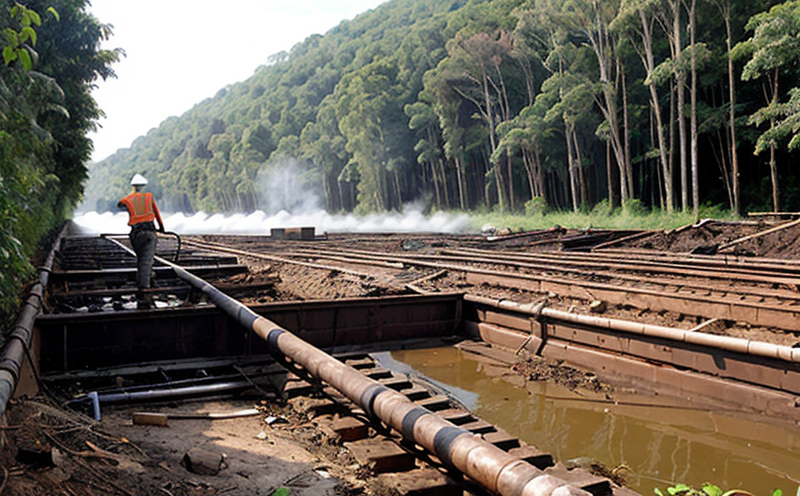EN 1948 Dioxins and Furans Emission Compliance Test
The EN 1948 standard is a critical tool for ensuring the environmental integrity of facilities that release dioxins and furans into the atmosphere. This test assesses the compliance with regulatory limits set to prevent harmful emissions from industrial processes, waste incineration plants, and other sources. Compliance testing is essential in safeguarding public health and the environment by minimizing exposure to these potent toxic pollutants.
Our service involves a comprehensive approach that begins with detailed sampling of exhaust gases or effluents to capture representative concentrations of dioxins and furans. The collected samples are then analyzed using advanced analytical techniques such as Gas Chromatography-Mass Spectrometry (GC-MS), which is the industry-standard for precise quantification.
The scope of this service extends beyond mere analysis; it includes providing detailed reports that outline compliance status, identify any areas where emissions exceed permissible limits, and offer recommendations to mitigate non-compliance. This proactive approach helps clients avoid costly fines and reputational damage while ensuring they meet their environmental responsibilities.
Our testing facilities are equipped with state-of-the-art laboratories that adhere to international standards, including ISO/IEC 17025 for proficiency in conducting the EN 1948 test. This ensures accuracy, reliability, and consistency of results across all samples analyzed.
The importance of this service cannot be overstated in today’s regulatory landscape. By offering EN 1948 compliance testing services, we empower our clients to maintain a sustainable operations framework that aligns with global environmental protection initiatives. Our expertise in this area is bolstered by years of experience and continuous investment in cutting-edge technology.
To further illustrate the significance of this service, let us consider an example scenario: A waste incineration plant located near residential areas undergoes regular EN 1948 testing to monitor dioxin emissions. The test results reveal that certain emission levels are slightly above permitted thresholds due to variations in fuel composition and combustion conditions. Our team provides insights into optimizing combustion processes, suggesting alternative fuels, or implementing additional pollution control measures.
Another critical aspect of our service is the generation of comprehensive reports that summarize findings and provide actionable recommendations. These documents serve multiple purposes: they inform decision-makers about necessary adjustments to operational protocols; offer guidance on improving environmental performance; and ensure full transparency with regulatory bodies.
In conclusion, our EN 1948 Dioxins and Furans Emission Compliance Test service plays a pivotal role in maintaining compliance with international standards while promoting sustainable practices. By leveraging advanced analytical methods and adhering to stringent quality controls, we deliver accurate, reliable results that contribute significantly towards protecting the environment.
Applied Standards
| Standard Number | Description |
|---|---|
| EN 1948:2016 | Determination of dioxins and furans in exhaust gases from combustion processes—Particular methods for the determination of certain polychlorinated dibenzo-p-dioxins (PCDDs), -furans (PCDFs) and -dibenzofurans (PCDFs) |
| ISO/IEC 17025 | General requirements for the competence of testing and calibration laboratories |
Scope and Methodology
The scope of our EN 1948 Dioxins and Furans Emission Compliance Test encompasses a range of activities aimed at ensuring accurate and reliable assessment of emissions. Our methodology begins with the selection of appropriate sampling points based on industry best practices, ensuring that representative samples are collected under controlled conditions.
Once sampled, these materials undergo rigorous preparation steps including filtration and stabilization to prevent degradation during analysis. The prepared samples are then subjected to GC-MS analysis, which involves multiple stages such as injection into the chromatography column followed by mass spectrometry detection. This process allows for precise identification and quantification of individual dioxin and furan congeners.
Following analysis, our team generates detailed reports that summarize findings in accordance with EN 1948 requirements. These documents not only provide numerical results but also interpret them within the context of applicable regulations and guidelines. Additionally, we offer recommendations for corrective actions where necessary to bring emissions back into compliance if they fall outside permitted limits.
The methodology employed by our laboratory adheres strictly to international standards such as ISO/IEC 17025, which guarantees adherence to best practices throughout the entire testing process from sample collection through final reporting. This commitment ensures that all tests conducted are both accurate and reliable, thereby enhancing trustworthiness among stakeholders.
Our approach also includes regular calibration of instruments used in the analysis to maintain precision and accuracy over time. Furthermore, we participate actively in proficiency testing programs organized by recognized bodies like EURACHEM, ensuring continuous improvement in analytical techniques and methodologies.
Competitive Advantage and Market Impact
In an increasingly competitive global market where environmental responsibility is a key differentiator, our EN 1948 Dioxins and Furans Emission Compliance Test service offers significant advantages. By offering accurate, reliable emissions data, we help clients stay ahead of regulatory changes and emerging trends in environmental protection.
Our comprehensive testing services not only ensure compliance with current regulations but also anticipate future requirements by providing detailed insights into emission patterns and sources. This foresight enables businesses to proactively implement strategies that enhance their sustainability credentials, thereby gaining a competitive edge over less environmentally conscious competitors.
The demand for such services continues to grow as governments worldwide strengthen environmental protections through stricter emissions limits and more stringent reporting requirements. Our clients benefit from staying compliant with these evolving regulations, which can lead to reduced operational costs due to optimized processes and avoided penalties associated with non-compliance.
Moreover, our service contributes positively towards corporate social responsibility initiatives by helping companies contribute meaningfully to reducing their carbon footprint and supporting broader environmental goals. This aligns well with growing consumer preference for eco-friendly products and services, further enhancing brand reputation and market positioning.
The success of this service is reflected in its widespread adoption across various sectors including energy production, waste management, chemical manufacturing, and more recently, renewable industries like solar and wind farms. As these industries expand globally, so too does the need for robust emission control measures supported by reliable testing services.





